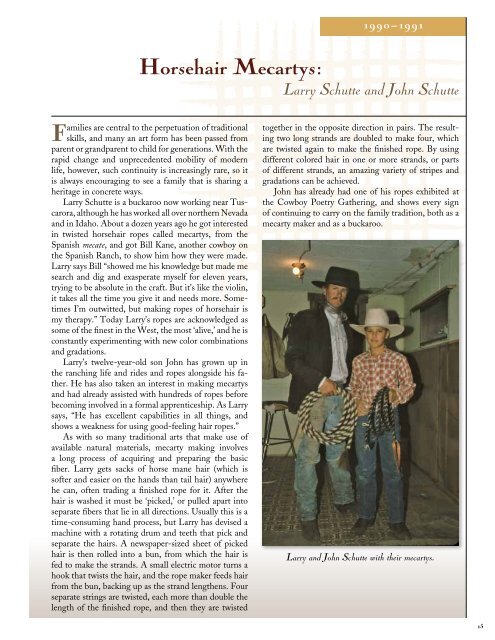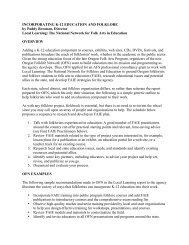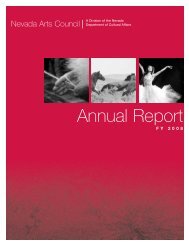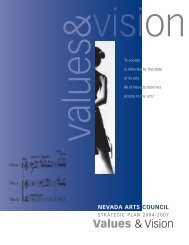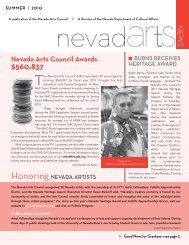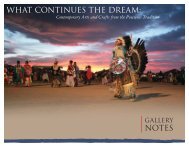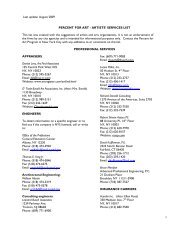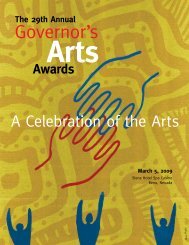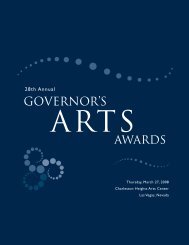Handed Down - Nevada Arts Council
Handed Down - Nevada Arts Council
Handed Down - Nevada Arts Council
Create successful ePaper yourself
Turn your PDF publications into a flip-book with our unique Google optimized e-Paper software.
1990–1991<br />
Horsehair Mecartys:<br />
Larry Schutte and John Schutte<br />
Families are central to the perpetuation of traditional<br />
skills, and many an art form has been passed from<br />
parent or grandparent to child for generations. With the<br />
rapid change and unprecedented mobility of modern<br />
life, however, such continuity is increasingly rare, so it<br />
is always encouraging to see a family that is sharing a<br />
heritage in concrete ways.<br />
Larry Schutte is a buckaroo now working near Tuscarora,<br />
although he has worked all over northern <strong>Nevada</strong><br />
and in Idaho. About a dozen years ago he got interested<br />
in twisted horsehair ropes called mecartys, from the<br />
Spanish mecate, and got Bill Kane, another cowboy on<br />
the Spanish Ranch, to show him how they were made.<br />
Larry says Bill “showed me his knowledge but made me<br />
search and dig and exasperate myself for eleven years,<br />
trying to be absolute in the craft. But it’s like the violin,<br />
it takes all the time you give it and needs more. Sometimes<br />
I’m outwitted, but making ropes of horsehair is<br />
my therapy.” Today Larry’s ropes are acknowledged as<br />
some of the finest in the West, the most ‘alive,’ and he is<br />
constantly experimenting with new color combinations<br />
and gradations.<br />
Larry’s twelve-year-old son John has grown up in<br />
the ranching life and rides and ropes alongside his father.<br />
He has also taken an interest in making mecartys<br />
and had already assisted with hundreds of ropes before<br />
becoming involved in a formal apprenticeship. As Larry<br />
says, “He has excellent capabilities in all things, and<br />
shows a weakness for using good-feeling hair ropes.”<br />
As with so many traditional arts that make use of<br />
available natural materials, mecarty making involves<br />
a long process of acquiring and preparing the basic<br />
fiber. Larry gets sacks of horse mane hair (which is<br />
softer and easier on the hands than tail hair) anywhere<br />
he can, often trading a finished rope for it. After the<br />
hair is washed it must be ‘picked,’ or pulled apart into<br />
separate fibers that lie in all directions. Usually this is a<br />
time-consuming hand process, but Larry has devised a<br />
machine with a rotating drum and teeth that pick and<br />
separate the hairs. A newspaper-sized sheet of picked<br />
hair is then rolled into a bun, from which the hair is<br />
fed to make the strands. A small electric motor turns a<br />
hook that twists the hair, and the rope maker feeds hair<br />
from the bun, backing up as the strand lengthens. Four<br />
separate strings are twisted, each more than double the<br />
length of the finished rope, and then they are twisted<br />
together in the opposite direction in pairs. The resulting<br />
two long strands are doubled to make four, which<br />
are twisted again to make the finished rope. By using<br />
different colored hair in one or more strands, or parts<br />
of different strands, an amazing variety of stripes and<br />
gradations can be achieved.<br />
John has already had one of his ropes exhibited at<br />
the Cowboy Poetry Gathering, and shows every sign<br />
of continuing to carry on the family tradition, both as a<br />
mecarty maker and as a buckaroo.<br />
Larry and John Schutte with their mecartys.<br />
15


